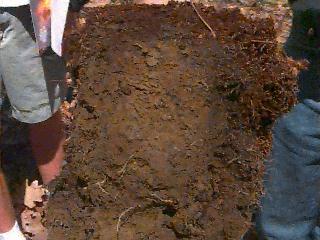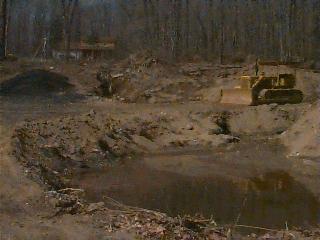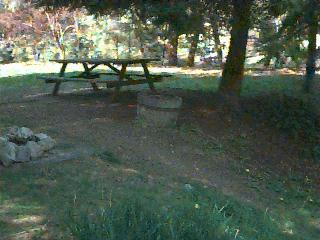 Earth Science
Earth Science Earth Science
Earth Science
To the right of each statement, record your notes on the verbal class discussions, examples, analogies, and drawings.
Classroom learning is never enough to fully understand any topic however. To really know something, you have to think about it on your own. To help you to do this, complete the following assignment for homework:
Under each statement, write a reference to where this information is found in your textbook or somewhere else in your notes, or you may write a reference to how we studied that statement in class. Standard classes: in addition to text pages assigned for homework, try text pages 507-510, 520, and 523. Honors classes: you're on your own.
You may also include references to other sources of information such as library
materials, encyclopedia, books,
online sources
etc.
Soil Development
1. Soil is a product of weathering with
many definitions;
Engineering: any loose material on top
of bedrock,
Maintainance: dirt,
Earth Science: weathered rock and
organic material.
Environmental: the Earth's living,
growing boundary between land and air
on which most plants and animals
depend for life.
REFERENCE:
 2. Residual soil: forms as products of
2. Residual soil: forms as products of
weathering remain in place, transported soil:
moved from somewhere else.
Topsoil: upper, organic layers of soil, aka loam.
Mineral soil: lower, inorganic layers of soil.
REFERENCE:
3. Most local soils are residual,
forming for 10,000 yrs, only 0-3 ft
thick. Our thickest soils along rivers,
base of hills are transported- piled
there by erosion forces. PHOTO
REFERENCE:
4. The characteristics of soil depend on: (a)the original parent material, (b) the slope, (c) the amount of moisture in the soil, (d) the length of time that the soil has been developing, (e) the climate, and (f) if the soil has been disturbed.
REFERENCE:
4.5 how can we determine what the soil was used for in the past?
REFERENCE:
 5. - Soil begins to form by p,c
5. - Soil begins to form by p,c
weathering of rock - parent material. PHOTO
Layer of weathered rock builds DOWN -
this is C horizon.
REFERENCE:
 6. Meanwhile, back at the surface,
6. Meanwhile, back at the surface,
organic material is falling on
top, rotting away, forming O layer, duff
on top. Duff is rotting stuff still
identifiable- O too rotted to ID. PHOTO
REFERENCE:
 7. The most weathered rock material -
7. The most weathered rock material -
just under the O layer - called A
horizon - water flowing down from
surface has leached minerals out of this
layer, carried organic material down
from surface into A horizon. PHOTO
REFERENCE:
 8. Minerals leached from A gets
8. Minerals leached from A gets
deposited in next layer down - called B
horizon - as clays, other products of
weathering. PHOTO
REFERENCE:
9. Natural fertility of soil depends on
amount of organic material (remember
N-fixing bacteria?), less on dissolved
minerals. Thicker organic O,A horizons =
better soil.
REFERENCE:
--------------------- SOIL MANAGEMENT ---------------------------------
1. The Enemy: the Raindrop. The basic
principle of soil conservation is to
protect soil particles from raindrop
impact. Duff does it for natural soils.
REFERENCE:
2. Soil management is learning about,
planning for, then use of your plan to
use soils without destroying them.
REFERENCE:
3. Timber harvesting: cutting down the
trees, removing the branches, dragging
the logs out of the woods to where they
can be loaded on trucks. Forest
harvesting does not necessarily destroy
a forest, but it does change it,
sometimes radically.
REFERENCE:
4. Different types of trees require
different cutting techniques: selective,
seed tree, clear cut etc. For all types,
dropping and lopping do not disturb soil
much - even when machines do all work-
but does change forest.
REFERENCE:
5. Skidding logs: dragging logs is what
exposes soil to rain drops, and this
could destroy the forest.
REFERENCE:
 6. Plan skid trails and landings along
6. Plan skid trails and landings along
slopes and on flat areas, not straight
up and down hills, and away from water PHOTO
REFERENCE:
7. Trees can be dropped onto skid path,
branches left on path or dragged onto
bare spots for machines and trees to go
over them, and trails should be seeded,
and then covered with hay wood chips, or
slash as soon as the operation is
complete.
REFERENCE:
8. Logs are loaded onto trucks at
landings, these should be flat, dry area
away from water, seed and cover as soon
as possible - but expect mud because
can't be covered during operations.
REFERENCE:
9. Replant or monitor natural
regeneration. If regeneration is slow,
areas should be replanted.
REFERENCE:
10. Agriculture: responsible for great
soil loss - loss worldwide, U.S. far
exceeds soil growth. Main reasons: high
production requires soil tilled
(plowed)- exposes soil to rain drops and
erosion, monoculture requires weeding-
crop only on soil exposes it between
plants.
REFERENCE:
11. Leave plant residue/waste products
on fields: combines removes corn ears,
leave behind stalks, remove wheat, leave
chaff, spread manure (except during
growing season, frozen fields),
production by-products.
REFERENCE:
12. No-Till: no plowing - disk slices
down into soil, seeds injected in slice.
drawback: more chemicals to kill weeds
(or accept production loss in crop),
equipment cost.
REFERENCE:
13. Erosion controls: contour plowing,
winter rye, windbreaks
REFERENCE:
14. Residential Soil Management: state,
local laws require controls on soil
erosion only at edges of property, not
protection from The Enemy.
REFERENCE:
15 House construction: topsoil, loam of
entire site is often dug up, hauled away
and sold - may not be necessary to do
whole site - better if topsoil only
removed from contruction areas, piled
and COVERED.
REFERENCE:
 16. Whole site mineral soil is often
16. Whole site mineral soil is often
exposed to rain - if possible,
contractor may be able to cover with
platic tarps overnight when rain
expected - not likely because of time,
expense.
REFERENCE:
17. Topsoil pile spread over site when
contruction done, landscape as soon as
posible.
REFERENCE:
 18. Maintain ground covers to prevent
18. Maintain ground covers to prevent
erosion while living on the property.
Watch out for high traffic, also shady
areas which may not have plants growing
- bare soil will erode - divert traffic
and/or cover with mulch, wood chips,
gravel, even sand is better than nothing
on bare soil areas.
REFERENCE:
19. Steep slopes: vegetation, divert
traffic, put in steps.
REFERENCE:
 20. If possible, where ground cover
20. If possible, where ground cover
cannot grow, replace eroding soil with a
hard surface of any kind ( pavement,
patio blocks, brick walk, etc): remove
all organic soil, fill with mineral
soil, use jointed surface (blocks or
brick) so water soaks in between and
does not flow over surface to increase
erosion.
REFERENCE:
21 Any water moving over surface: divert
to areas where it can soak in -
particles will get trapped in soil
instead of entering streams.
REFERENCE:
HOMEWORK: 1. Try to find a textbook, notebook, or some other
reference for each item on this Soil Management Notetaking Guide. 2.
Design a plan to protect soil in your yard or another area by mapping
the area's bare soil, then deciding what to do about it.
(Return to top of page)
 Earth Science
Earth Science